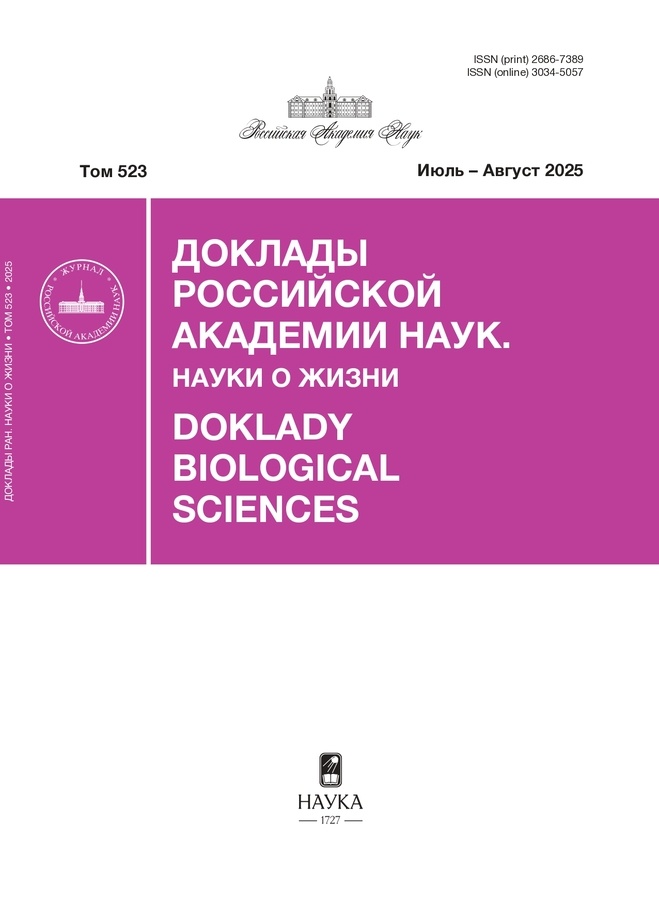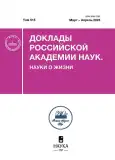Модуль RRE-REV не оказывает влияния на эффективность упаковки белков cas9 и Gag в вирусоподобные частицы системы Nanomedic
- Авторы: Круглова Н.А.1, Комков Д.С.1,2, Мазуров Д.В.1,3, Шепелев М.В.1
-
Учреждения:
- Институт биологии гена Российской академии наук
- Ben-Gurion University of the Negev
- University of Minnesota
- Выпуск: Том 515, № 1 (2024)
- Страницы: 64-70
- Раздел: Статьи
- URL: https://gynecology.orscience.ru/2686-7389/article/view/651443
- DOI: https://doi.org/10.31857/S2686738924020121
- EDN: https://elibrary.ru/WFAFTA
- ID: 651443
Цитировать
Полный текст
Аннотация
Доставка рибонуклеопротеиновых комплексов нуклеазы Cas9 и гидовой РНК в клетки-мишени в формате вирусоподобных частиц (VLP, virus-like particles) – один новых методов геномного редактирования, в перспективе пригодный для генной терапии заболеваний человека. Эффективность редактирования генома с помощью VLP зависит от упаковки в них нуклеазы Cas9, что опосредуется вирусным белком Gag. Для улучшения упаковки Cas9 в VLP системы NanoMEDIC плазмидные конструкции для экспрессии Cas9 и Gag были модифицированы добавлением элемента RRE (Rev response element) вируса ВИЧ, который должен повышать экспорт RRE-содержащих транскриптов из ядра в цитоплазму за счет акцессорного белка Rev, как описано для системы VLP на основе Vpr-Cas9. Было установлено, что уровни белков Cas9 и Gag в лизатах клеток повышаются при котрансфекции как плазмиды для экспрессии Rev, так и контрольной пустой плазмиды, и этот эффект не зависит от наличия RRE-элемента в транскрипте. Кроме того, установлено, что основную роль при упаковке Cas9 в частицы системы NanoMEDIC играет AP21967-индуцированная димеризация FRB и FKBP12, но не модификация плазмид с помощью элемента RRE и/или котрансфекция плазмиды, экспрессирующей Rev. Полученные результаты указывают на нецелесообразность использования RRE-Rev модуля для улучшения упаковки нуклеазы Cas9 в VLP.
Полный текст
Об авторах
Н. А. Круглова
Институт биологии гена Российской академии наук
Email: mshepelev@mail.ru
Россия, Москва
Д. С. Комков
Институт биологии гена Российской академии наук; Ben-Gurion University of the Negev
Email: mshepelev@mail.ru
Центр высокоточного редактирования и генетических технологий для биомедицины, Department of Physiology and Cell Biology, Faculty of Health Sciences
Россия, Москва; Израиль, Be’erShevaД. В. Мазуров
Институт биологии гена Российской академии наук; University of Minnesota
Email: mshepelev@mail.ru
Центр высокоточного редактирования и генетических технологий для биомедицины, Division of Infectious Diseases and International Medicine, Department of Medicine
Россия, Москва; USA, MinneapolisМ. В. Шепелев
Институт биологии гена Российской академии наук
Автор, ответственный за переписку.
Email: mshepelev@mail.ru
Россия, Москва
Список литературы
- Doudna J.A. // Nature. 2020. V. 578. № 7794. P. 229–236.
- Lino C.A., Harper J.C., Carney J.P., Timlin J.A. // Drug Deliv. 2018. V. 25. № 1. P. 1234–1257.
- Mazurov D., Ramadan L., Kruglova N. // Viruses. 2023. V. 15. № 3. P. 690.
- Banskota S., Raguram A., Suh S., Du S.W., Davis J.R., Choi E.H., Wang X., Nielsen S.C., Newby G.A., Randolph P.B., et al. // Cell. 2022. V. 185. № 2. P. 250-265.e16.
- Gee P., Lung M.S.Y., Okuzaki Y., Sasakawa N., Iguchi T., Makita Y., Hozumi H., Miura Y., Yang L.F., Iwasaki M., et al. // Nat Commun. 2020. V. 11. № 1. P. 1334.
- Mangeot P.E., Risson V., Fusil F., Marnef A., Laurent E., Blin J., Mournetas V., Massouridès E., Sohier T.J.M., Corbin A., et al. // Nat Commun. 2019. V. 10. № 1. P. 45.
- Hamilton J.R., Tsuchida C.A., Nguyen D.N., Shy B.R., McGarrigle E.R., Sandoval Espinoza C.R., Carr D., Blaeschke F., Marson A., Doudna J.A. // Cell Rep. 2021. V. 35. № 9. P. 109207.
- Montagna C., Petris G., Casini A., Maule G., Franceschini G.M., Zanella I., Conti L., Arnoldi F., Burrone O.R., Zentilin L., et al. // Mol Ther Nucleic Acids. 2018. V. 12. P. 453–462.
- Fernandes J., Jayaraman B., Frankel A. // RNA Biol. 2012. V. 9. № 1. P. 6–11.
- Pocock G. M., Becker J.T., Swanson C.M., Ahlquist P., Sherer N.M. // PLoS Pathog. 2016. V. 12. № 4. P. e1005565.
- Indikova I., Indik S. // Nucleic Acids Res. 2020. V. 48. № 14. P. 8178–8187.
- Mazurov D., Ilinskaya A., Heidecker G., Lloyd P., Derse D. // PLoS Pathog. 2010. V. 6. № 2. P. e1000788.
- Dull T., Zufferey R., Kelly M., Mandel R.J., Nguyen M., Trono D., Naldini L. // J Virol. 1998. V. 72. № 11. P. 8463–8471.
- Stewart S.A., Dykxhoorn D.M., Palliser D., Mizuno H., Yu E.Y., An D.S., Sabatini D.M., Chen I.S.Y., Hahn W.C., Sharp P.A., et al. // RNA. 2003. V. 9. № 4. P. 493–501.
- Han X., Liu Z., Ma Y., Zhang K., Qin L. // Adv Biosyst. 2017. V. 1. № 1–2. P. e1600007.
- Hu Q., Suzuki K., Hirschler-Laszkiewicz I., Rothblum L.I. // Biotechniques. 2002. V. 33. № 1. P. 74, 76, 78 passim.
- Stepanenko A.A., Heng H.H. // Mutat Res Rev Mutat Res. 2017. V. 773. P. 91–103.
Дополнительные файлы












